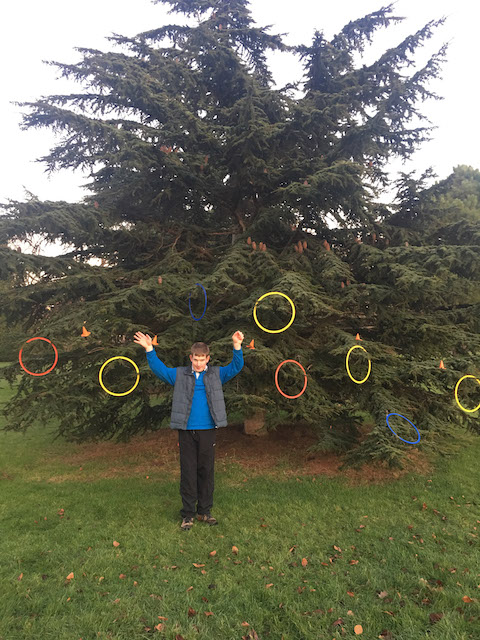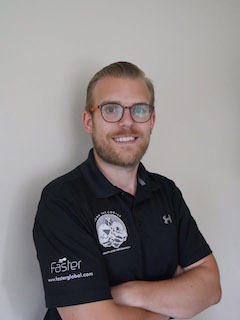Every session with a client needs to be structured to their individual needs and goals. However, there may be elements of this sample session by Oliver Pearce that can be incorporated into your session preparations.
Client goals
Edward has autism, which affects his concentration levels and co-ordination skills with certain tasks. To keep him focused, I have to make exercises fun and exciting otherwise he becomes distracted and frustrated. He has a love of many things and this is the key to how we successfully work together. Edward doesn’t have goals as such, he simply comes to me to have fun and to play. The goals for him are socially driven by his family and care team and are things such as improving his life skills, walking, using his fingers for finer dexterity tasks, and also to raise his confidence with independent choices. Skills such as balance, doing tasks for himself such as choosing a colour ball to throw without me helping him choose, and simply playing hide and seek increase his confidence.
Considerations
Working with Edward is very much about communication. The words I use and how they’re spoken, the facial expressions and body language I use and he shows, gives me an understanding of his feelings towards each task. I make it important to build games around things he enjoys such as food, trains, cartoons, animals, colours and sounds.
 First, we do a choice game working on his quick decision making. He selects an order of coloured floor pads and he jumps on the coloured ones and hops onto black pads. This works the legs along with co-ordination and timing, giving him the skills to balance on each pad and transitioning from one leg to two at different speeds. We also play a game where I hide behind a tree, sending him 25ft away to choose a coloured ball out of a bag on the floor, enabling him to squat and helping with his confidence on being on his own. The bag contains different coloured balls, varying in texture, size and weight. I then make a beep noise that means he needs to make a quick decision and run quickly over to me, jumping small hurdles on route to finish by throwing the ball into a small net that has a points scoring system. These games are all about communication, hand-to-eye co-ordination, and working the motor skills he finds tough, to improve them week by week.
First, we do a choice game working on his quick decision making. He selects an order of coloured floor pads and he jumps on the coloured ones and hops onto black pads. This works the legs along with co-ordination and timing, giving him the skills to balance on each pad and transitioning from one leg to two at different speeds. We also play a game where I hide behind a tree, sending him 25ft away to choose a coloured ball out of a bag on the floor, enabling him to squat and helping with his confidence on being on his own. The bag contains different coloured balls, varying in texture, size and weight. I then make a beep noise that means he needs to make a quick decision and run quickly over to me, jumping small hurdles on route to finish by throwing the ball into a small net that has a points scoring system. These games are all about communication, hand-to-eye co-ordination, and working the motor skills he finds tough, to improve them week by week.
Rationale
The feedback from the last two years has been immense: he has lost two stone; he will go walking in the rain and the mud; and he will choose things when shopping without help from his mum. Edward’s speech and language has also improved, he doesn’t worry when left on his own for a few seconds, and his behaviour has changed. Exercise doesn’t have to be about muscles and joints; the activation you think you’re creating because of the loading tool you’re using. Work with the person and make them be the reason you build your exercises.
Session in brief
Warm-up: Walking and chatting, playing football and kicking the ball high with a bit of catching.
Lower body: Jumps and hops, stepping high over hurdles and crouching to get under tree branches.
Upper body: Throwing movements, bodyweight arm reaches and putting clothes pegs on trees to get the arms above the head for a longer time.
Core exercises: All the exercises work the core as I have to factor in that arms up or to the side move the ribs away from the pelvis or the pelvis away from the ribs.
Cool-down: We simply clear up all the equipment, Edward calls his carer/ mum, and we walk briskly back to the car where we pack it all away.
This previously featured in the Fitpro digital magazine.

Oliver Pearce has been a trainer for 14 years specialising in Injury Rehabilitation and recovery post life-changing illnesses. From his education with Faster Health & Fitness and working alongside health professionals, he ensures each client has the best possible chance at recovery. His ability to research means he’s always learning and is up to date with the most current studies and science in the industry. Oliver is a personal trainer at Turn the Corner Health & Performance and whatever the issue, he helps the client to identify and achieve their ultimate goal, working to overcome the hurdles they face through fun, innovative and science-based training.







